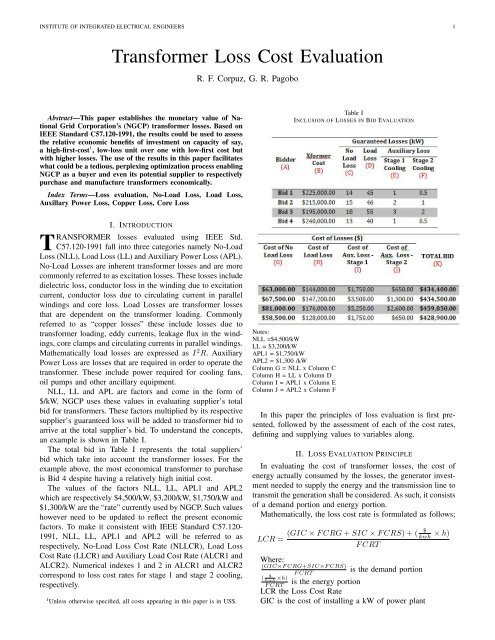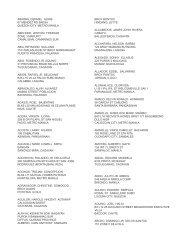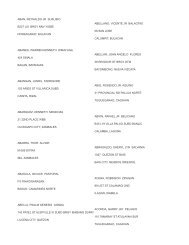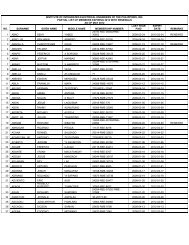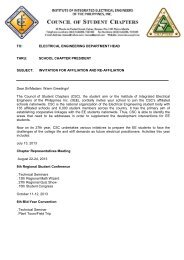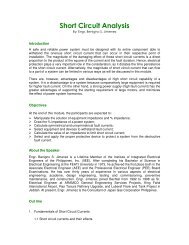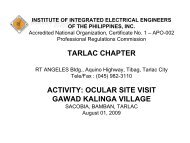2012-Transformer-loss_eva... - Institute of Integrated Electrical ...
2012-Transformer-loss_eva... - Institute of Integrated Electrical ...
2012-Transformer-loss_eva... - Institute of Integrated Electrical ...
You also want an ePaper? Increase the reach of your titles
YUMPU automatically turns print PDFs into web optimized ePapers that Google loves.
INSTITUTE OF INTEGRATED ELECTRICAL ENGINEERS 1<br />
<strong>Transformer</strong> Loss Cost Evaluation<br />
R. F. Corpuz, G. R. Pagobo<br />
Abstract—This paper establishes the monetary value <strong>of</strong> National<br />
Grid Corporation’s (NGCP) transformer <strong>loss</strong>es. Based on<br />
IEEE Standard C57.120-1991, the results could be used to assess<br />
the relative economic benefits <strong>of</strong> investment on capacity <strong>of</strong> say,<br />
a high-first-cost 1 , low-<strong>loss</strong> unit over one with low-first cost but<br />
with higher <strong>loss</strong>es. The use <strong>of</strong> the results in this paper facilitates<br />
what could be a tedious, perplexing optimization process enabling<br />
NGCP as a buyer and even its potential supplier to respectively<br />
purchase and manufacture transformers economically.<br />
Index Terms—Loss <strong>eva</strong>luation, No-Load Loss, Load Loss,<br />
Auxillary Power Loss, Copper Loss, Core Loss<br />
Table I<br />
INCLUSION OF LOSSES IN BID EVALUATION<br />
I. INTRODUCTION<br />
TRANSFORMER <strong>loss</strong>es <strong>eva</strong>luated using IEEE Std.<br />
C57.120-1991 fall into three categories namely No-Load<br />
Loss (NLL), Load Loss (LL) and Auxiliary Power Loss (APL).<br />
No-Load Losses are inherent transformer <strong>loss</strong>es and are more<br />
commonly referred to as excitation <strong>loss</strong>es. These <strong>loss</strong>es include<br />
dielectric <strong>loss</strong>, conductor <strong>loss</strong> in the winding due to excitation<br />
current, conductor <strong>loss</strong> due to circulating current in parallel<br />
windings and core <strong>loss</strong>. Load Losses are transformer <strong>loss</strong>es<br />
that are dependent on the transformer loading. Commonly<br />
referred to as “copper <strong>loss</strong>es” these include <strong>loss</strong>es due to<br />
transformer loading, eddy currents, leakage flux in the windings,<br />
core clamps and circulating currents in parallel windings.<br />
Mathematically load <strong>loss</strong>es are expressed as I 2 R. Auxiliary<br />
Power Loss are <strong>loss</strong>es that are required in order to operate the<br />
transformer. These include power required for cooling fans,<br />
oil pumps and other ancillary equipment.<br />
NLL, LL and APL are factors and come in the form <strong>of</strong><br />
$/kW. NGCP uses these values in <strong>eva</strong>luating supplier’s total<br />
bid for transformers. These factors multiplied by its respective<br />
supplier’s guaranteed <strong>loss</strong> will be added to transformer bid to<br />
arrive at the total supplier’s bid. To understand the concepts,<br />
an example is shown in Table I.<br />
The total bid in Table I represents the total suppliers’<br />
bid which take into account the transformer <strong>loss</strong>es. For the<br />
example above, the most economical transformer to purchase<br />
is Bid 4 despite having a relatively high initial cost.<br />
The values <strong>of</strong> the factors NLL, LL, APL1 and APL2<br />
which are respectively $4,500/kW, $3,200/kW, $1,750/kW and<br />
$1,300/kW are the “rate” currently used by NGCP. Such values<br />
however need to be updated to reflect the present economic<br />
factors. To make it consistent with IEEE Standard C57.120-<br />
1991, NLL, LL, APL1 and APL2 will be referred to as<br />
respectively, No-Load Loss Cost Rate (NLLCR), Load Loss<br />
Cost Rate (LLCR) and Auxiliary Load Cost Rate (ALCR1 and<br />
ALCR2). Numerical indexes 1 and 2 in ALCR1 and ALCR2<br />
correspond to <strong>loss</strong> cost rates for stage 1 and stage 2 cooling,<br />
respectively.<br />
1 Unless otherwise specified, all costs appearing in this paper is in US$.<br />
Notes:<br />
NLL =$4,500/kW<br />
LL = $3,200/kW<br />
APL1 = $1,750/kW<br />
APL2 = $1,300 /kW<br />
Column G = NLL x Column C<br />
Column H = LL x Column D<br />
Column I = APL1 x Column E<br />
Column J = APL2 x Column F<br />
In this paper the principles <strong>of</strong> <strong>loss</strong> <strong>eva</strong>luation is first presented,<br />
followed by the assessment <strong>of</strong> each <strong>of</strong> the cost rates,<br />
defining and supplying values to variables along.<br />
II. LOSS EVALUATION PRINCIPLE<br />
In <strong>eva</strong>luating the cost <strong>of</strong> transformer <strong>loss</strong>es, the cost <strong>of</strong><br />
energy actually consumed by the <strong>loss</strong>es, the generator investment<br />
needed to supply the energy and the transmission line to<br />
transmit the generation shall be considered. As such, it consists<br />
<strong>of</strong> a demand portion and energy portion.<br />
Mathematically, the <strong>loss</strong> cost rate is formulated as follows;<br />
LCR =<br />
(GIC × F CRG + SIC × F CRS) + (<br />
$<br />
kwh × h)<br />
F CRT<br />
Where:<br />
(GIC×F CRG+SIC×F CRS)<br />
F CRT<br />
( $<br />
kwh ×h)<br />
is the demand portion<br />
F CRT<br />
is the energy portion<br />
LCR the Loss Cost Rate<br />
GIC is the cost <strong>of</strong> installing a kW <strong>of</strong> power plant
INSTITUTE OF INTEGRATED ELECTRICAL ENGINEERS 2<br />
SIC is the cost installing transmission line with a kW <strong>of</strong><br />
capacity<br />
Loss Cost Rate refers to NLLCR or LLCR or<br />
ALCR1/ALCR2<br />
FCRG is the Fixed Charge Rate <strong>of</strong> Generating Plant<br />
FCRT is the Fixed Charge Rate <strong>of</strong> <strong>Transformer</strong><br />
FCRS is the Fixed Charge Rate <strong>of</strong> Transmission<br />
h is the number <strong>of</strong> hours per year that transformer is<br />
energized<br />
The Fixed Charge Rate <strong>of</strong> Plant/<strong>Transformer</strong> refers to that<br />
portion <strong>of</strong> investment needed per year to support the capital<br />
investment. In its simplest form, it represents the required<br />
yearly income from the investment. Its components are as<br />
follows;<br />
1) Minimum Acceptable Rate <strong>of</strong> Return<br />
2) Annual Cost <strong>of</strong> Depreciation and<br />
3) Taxes<br />
For purposes <strong>of</strong> this study, FCRT and FCRS are equated<br />
to NGCP’s Weighted Average Cost <strong>of</strong> Capital (WACC) for<br />
the second regulatory period which is 15.87%. FCRG is set<br />
equivalent to 15%, NEDA’s Social Discount Rate.<br />
The numerator in the equation for the Loss Cost Rate<br />
represents the cost per year to provide a continuous kW<br />
<strong>of</strong> <strong>loss</strong>. The first term (GIC × F CRG + SIC × F CRS)<br />
represents that portion <strong>of</strong> investment cost on a generation and<br />
transmission needed per year to support transformer <strong>loss</strong>es<br />
while the second term represents the cost <strong>of</strong> the energy under<br />
the present pr<strong>eva</strong>iling energy cost. For Luzon, the current year<br />
energy cost, CYEC, is set to $0.1444/kWh This is based on<br />
P7.04/kWh 2 energy rate and P48.65/$1 3 peso-dollar exchange<br />
rate.<br />
III. NO LOAD LOSS COST RATE<br />
Following the principles in Section II, the No Load Loss<br />
Cost Rate is determined as follows;<br />
NLLCR =<br />
(GIC×F CRG + SIC×F CRS) + LECN<br />
ET ×F CRT ×IF<br />
Except for ET and IF terms in the denominator, the formula<br />
for NLLCR is similar to the equation for transformer<br />
<strong>loss</strong> in Section II. Note that LECN, the Levelized No Load<br />
Energy cost, is the energy portion in Section II equivalent<br />
to US$ 1,573.43/kWyear for Luzon. LECN is determined in<br />
Section VI. ET and IF are dimensionless factors introduced<br />
to reflect the Efficiency <strong>of</strong> Transmission and Increase Factor<br />
respectively. ET is determined through power flow simulations<br />
and is set to 0.9783 for Luzon Grid. To simplify calculations,<br />
IF is set to 1.007 4 and only reflects project overhead cost.<br />
By introducing ET, the calculated energy, in terms <strong>of</strong> cost<br />
is marked-up to include other costs dissipated through inefficiency.<br />
IF further increments this cost in proportion to project’s<br />
overhead cost.<br />
2 Figures from PSALM<br />
3 Exchange rate forecast from Economist Intelligence Unit as used by NGCP<br />
in the 3rd Reg. Filing<br />
4 Based on actual budget<br />
Values for other variables are as follows;<br />
Generation Installation Cost GIC = $1,600/kW<br />
Generation Installation Cost SIC = $2.74/kW 5<br />
Solving for NLLCR for Luzon Grid;<br />
NLLCR =<br />
(1, 600×0.15 + 2.74×0.1444) + 1, 573.43<br />
(0.9783×0.1587×1.007)<br />
NLLCR = $11, 601.60/kW<br />
IV. LOAD LOSS COST RATE<br />
For the Load Loss Cost Rate, there is a need to remove<br />
the impact <strong>of</strong> the Availability Factor AF 6 from LECN, as<br />
calculated in Section VI since for this <strong>loss</strong> rate <strong>Transformer</strong><br />
Loading Factor TLF will be used. Modifying LECN in this<br />
manner results to LECL or the Levelized Load Energy Cost,<br />
LECL is determined as follows:<br />
LECL = LECN<br />
AF<br />
=<br />
1, 573.43<br />
0.9897<br />
1, 589.8<br />
=<br />
kW<br />
year<br />
With the denominator remaining the same as that for No-<br />
Load Loss Cost Rate, the equation for the Load Loss Cost<br />
Rate is:<br />
LLCR = (GIC×F CRG + SIC×F CRS)×P RF 2 ×P UL 2<br />
(ET ×F CRT ×IF )<br />
2<br />
LECL×T LF<br />
+<br />
(ET ×F CRT ×IF )<br />
The new terms in the numerator are dimensionless adjustment<br />
factors introduced to enable realistic assessment. The<br />
Peak-Per Unit Load (PUL) relates demand-associated <strong>loss</strong>es to<br />
full rated transformer and not to the peak transformer load 7 . It<br />
is the average <strong>of</strong> yearly peaks over the lifetime <strong>of</strong> transformer<br />
divided by the rating at which the load <strong>loss</strong>es are guaranteed<br />
to be tested. For this study, load <strong>loss</strong>es are assumed to be<br />
tested at full-load transformer rating. Using load forecast data<br />
for 2009, PUL is set to 1.114 for Luzon.<br />
The Peak Responsibility Factor (PRF) is the transformer’s<br />
load during system peak 8 , divided the transformer’s peak load.<br />
This factor is intended to compensate for the transformer<br />
peak load <strong>loss</strong>es not occurring at the system peak <strong>loss</strong>es.<br />
The rationale is, if the entire transformer peak does not<br />
occur during the system peak, then there is no need to put<br />
up additional generation since the transformer load and its<br />
<strong>loss</strong>es could be supplied by the system. That is reason behind<br />
inclusion <strong>of</strong> PRF in the demand portion <strong>of</strong> the <strong>loss</strong> assessment<br />
equation. The data used in the determination <strong>of</strong> this parameter<br />
5 Based on $27,365.00/km, 2008 Price Level <strong>of</strong> 5km, 69kV ST/SC, 1-336.4<br />
MCM ACSR<br />
6 Availability Factor AF is the expected percentage <strong>of</strong> time the transformer<br />
will be energize. AF = 0.9897<br />
7 Guide for the Evaluation <strong>of</strong> Large Power <strong>Transformer</strong> Losses, USDA<br />
8 System Peak assumed to occur at 1900H
INSTITUTE OF INTEGRATED ELECTRICAL ENGINEERS 3<br />
was surveyed from various NGCP substations. Using the data,<br />
PRF for Luzon is set to 0.8643.<br />
The <strong>Transformer</strong> Loading Factor is the ratio <strong>of</strong> the average<br />
transformer <strong>loss</strong>es to the peak transformer <strong>loss</strong>es during a<br />
specific period <strong>of</strong> time . To simplify calculations, it is assumed<br />
constant and does not change significantly over the life <strong>of</strong><br />
transformer. It is formulated as;<br />
Where:<br />
LF is the Load Factor<br />
T LF = 0.8 × LF 2 + 0.2 × LF<br />
Using the equation above and the surveyed data from<br />
various NGCP substations, the average TLF for Luzon Grid<br />
is 0.6480.<br />
Substituting values and calculating for the Load Loss Cost<br />
Rate for Luzon Grid;<br />
LLCR = (1, 600×0.15 + 2.74×0.1587)×0.86432 ×1.114 2 )<br />
(0.97742×0.1587×1.007)<br />
For Stage 2 Cooling:<br />
3, 100<br />
LAEC2 = 1, 573.43×<br />
8, 669.77 = $562.605<br />
kW<br />
year<br />
ALCR2 =<br />
(1, 600×0.15 + 2.74×0.1587) + 562.60)<br />
(0.9783×0.1587×1.007)<br />
ALCR2 =<br />
$5, 136.38<br />
kW<br />
Table II is a summary <strong>of</strong> the Loss Cost Rate for Luzon,<br />
Visayas and Mindanao Grids determined through the methodology<br />
presented above.<br />
Table II<br />
TRANSFORMER LOSS EVALUATION FOR LUZON, VISAYAS AND<br />
MINDANAO GRIDS<br />
1, 589.80×0.64802<br />
+<br />
(0.97742×0.1587×1.007)<br />
LLCR = $5, 695.54/kW<br />
V. AUXILIARY LOAD LOSS COST RATE<br />
For the Auxiliary Loss Cost Rate Stage 1 (ALCR1), only the<br />
energy portion <strong>of</strong> the <strong>loss</strong> equation has to be modified. LECN<br />
has to be proportionately adjusted to the average number<br />
<strong>of</strong> hours that stage 1 cooling is expected to operate. The<br />
Levelized Auxiliary Energy Loss Cost – Stage 1 Cooling<br />
(LAEC1) is computed as follows;<br />
LAEC1 = LECN ×<br />
h stage1<br />
8760×AF<br />
Where:<br />
h stage1 is the average hours stage 1 cooling is running<br />
Substituting:<br />
4, 700<br />
LAEC1 = 1, 573.43 ×<br />
8, 669.77 = $852.98<br />
kW<br />
year<br />
Using the value determined for LAEC1, the Auxiliary Loss<br />
Cost Rate Stage 1 (ALCR1) is calculated as follows:<br />
ALCR1 =<br />
ALCR1 =<br />
(GIC×F CRG + SIC×F CRS)<br />
(ET ×F CRT ×IF )<br />
LAEC1<br />
+<br />
(ET ×F CRT ×IF )<br />
(1, 600×0.15 + 2.74×0.1587) + 852.978)<br />
(0.9783×0.1587×1.007)<br />
ALCR1 = $6, 993.67/kW<br />
VI. DETERMINATION OF LEVELIZED NO-LOAD ENERGY<br />
COST<br />
The cost <strong>of</strong> energy, as with any other commodity, is subject<br />
to inflation. Economic studies, such as this transformer <strong>loss</strong><br />
<strong>eva</strong>luation, would require more complicated techniques to<br />
assess exponential variables. One method <strong>of</strong> simplifying the<br />
problem is to levelize the values <strong>of</strong> the variables, this way the<br />
rate <strong>of</strong> energy would be equal during the entire booklife <strong>of</strong><br />
the transformer.<br />
As an example consider a cost <strong>of</strong> $1/kWh escalating at<br />
5% per annum, that is, its rate after a year is 1(1.05), after<br />
two years 1(1.05)(1.05) and so on until N years when its rate<br />
becomes 1(1.05)N. In the Figure 1 below the exponential cost<br />
<strong>of</strong> energy is the increasing curve below. The dashed line results<br />
after levelling.<br />
Levelling is achieved by multiplying the Net Present Value<br />
<strong>of</strong> all yearly energy rates by the Capital Recovery Factor<br />
(CRF) given by the following equation:<br />
CRF =<br />
r(1 + r)N<br />
(1 + r) N − 1<br />
Where:<br />
r is the Rate <strong>of</strong> Return, in the context <strong>of</strong> this study it is<br />
equal to WACC = 15.87%<br />
N is equal to 35 years, the booklife <strong>of</strong> transformer
INSTITUTE OF INTEGRATED ELECTRICAL ENGINEERS 4<br />
Figure 2.<br />
Cash Flow. Concept <strong>of</strong> Net Present Value<br />
Figure 1.<br />
Illustration <strong>of</strong> Levelization<br />
LECN =<br />
$1, 573.32<br />
kW<br />
year<br />
Applying the values and solving for CRF:<br />
CRF =<br />
0.1587(1 + 0.1587)35<br />
(1 + 0.1587) 35 − 1 = 0.159621<br />
The Net Present Value (NPV) is determined using the<br />
following equation:<br />
Where:<br />
∑35<br />
NP V = (1 + r) −N (1 + i) N (CY EC)<br />
N=1<br />
r and N is as given in CRF calculation<br />
i is the escalation rate equivalent to 3% 9<br />
CYEC is the Current Year Energy Cost equivalent to<br />
$0.1444/kWh<br />
The first term in the NPV equation equates the rate <strong>of</strong> energy<br />
in the Nth year which is (1 + i) N (CY EC) in terms <strong>of</strong> the<br />
present values. In other words it determines how much must<br />
be invested today at an interest rate “r” in order to have (1 +<br />
i) N (CY EC) in the future. Figure 2 illustrates the principle.<br />
The sum <strong>of</strong> these present values is the Net Present Value.<br />
Substituting variables and solving for NPV:<br />
The value 0.9897 appearing in the equation above is the<br />
Availability Factor (AF). This figure was determined from<br />
2005-2009 transformer outage statistics from System Operations.<br />
Following the same methodology, LECN for Visayas and<br />
Mindanao Grids are as follows:<br />
LECN =<br />
LECN =<br />
$1, 367.81<br />
kW<br />
year<br />
$2, 219.34<br />
kW<br />
year<br />
Rex F. Corpuz is a former Sr. VP <strong>of</strong> the National Transmission Corporation<br />
and a former President <strong>of</strong> National Grid Corporation <strong>of</strong> the Philippines<br />
(NGCP). He is presently the Sr. Technical Adviser at the Office <strong>of</strong> the<br />
President, NGCP. He is also a former Regional Governor <strong>of</strong> IIEE Region<br />
1., e-mail: rfcorpuz@gmail.com<br />
∑35<br />
NP V = (1 + 0.1587) −N (1 + 0.03) N (0.1444) = 1.13697<br />
N=1<br />
The Calculated Levelized No-Load Energy Cost (LECN)<br />
for Luzon Grid is equal to:<br />
LECN = NP V ×CRF ×8760×AF<br />
Gerald R. Pagobo is a Power System Consultant and formerly worked with<br />
the research group <strong>of</strong> NGCP. He received his MS in <strong>Electrical</strong> Engineering<br />
degree from the University <strong>of</strong> the Philippines in 2009. His research interests<br />
include reliability engineering, power system dynamic stability, electricity<br />
market optimization, and computer-based power system modeling and analysis.<br />
Email: grpagobo@gmail.com<br />
LECN = 1.13697×0.159621×8760×0.9897<br />
9 Escalation rate for 2009 figures as used by Project Management. Note a<br />
constant rate <strong>of</strong> 3% is assumed for the entire book life <strong>of</strong> transformer


